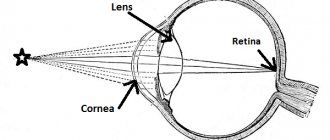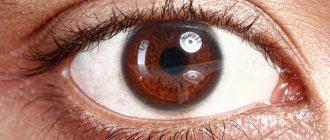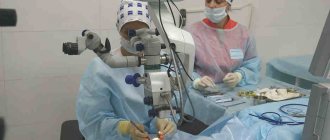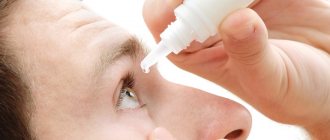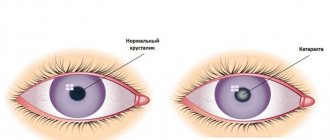- Laser correction
- Using eye drops
- Proper nutrition
The inevitable aging of the body affects, first of all, the condition of the eye apparatus. Is it possible to correct and restore lost vision over the years? Let's study issues related to the most common types of health problems. We will understand everything about age-related changes in vision after 40 years, find out options on how to slow down some of the processes, and maintain a familiar view of the world.
Why does visual acuity change after 40-50 years?
The lens inside the eye ages, or rather becomes denser. It is this process that affects focusing (especially noticeable when viewing close objects).
A change in vision after 40 years, unfortunately, awaits everyone. People with myopia or, conversely, with farsightedness suffer from age-related sharp changes in vision.
How does a person's age affect their vision?
Over the years, the lens becomes covered with additional fibers, the elasticity of which is different from the eyes in a young body. As a result, after 40-45 years, age-related changes in visual acuity - this core of the lens has become denser.
The ocular apparatus contains the ciliary muscle, the normal functioning of which requires greater load with age. This feels like additional effort for our eyes. The muscle itself should distort the lens, but since it has become less soft, hence the age-related changes in vision with age.
Diagnostics
To diagnose phacosclerosis, specialists examine the lens in side lighting using a 20D lens. Which reveals changes in the shape of the lens.
Biomicroscopy in diagnostic studies allows the ophthalmologist to obtain the necessary data on the position, shape and color of the lens, and to identify the location of opacities.
To clarify the details of the disease, an ultrasound A-scan (echobiometry) is prescribed, which makes it possible to detail the previously obtained results.
Treatment and restoration of age-related vision changes
There are several common eye diseases for older people:
- Glaucoma. This is a whole group of people aged, often already of retirement age. But it is precisely the beginnings of such a disease that are revealed after 40 years. The most important symptom for the development of glaucoma is intraocular pressure, myopia or hyperopia of a high degree. A decrease in visual acuity in a neglected state can easily lead to blindness. There is also an important psychological factor: already developed glaucoma cannot be cured, which becomes clear by the age of 50.
- Presbyopia. Once again, the familiar words about changing the lens, or rather its dragging. It is this disease that progresses with everyone, which is why people over 50 often change the diopters of their night lenses.
- Cataract. One of the most famous diseases, at the same time, is a natural age-related change. It is cataracts that are most often operated on in modern medicine. Moreover, technology does not stand still, and after surgery people often see much better than they have seen in the last 10-15 years.
- Retina (pathologies). There are many possible violations here. This is caused precisely by diseases of the internal organs, hypertension, diabetes, diseases of the adrenal glands and kidneys. In case of retinal pathology, there is just the possibility of operable restoration (laser coagulation).
Laser correction
So, it becomes clear that laser correction of age-related vision changes is suitable for diseases that are caused by complications that are not difficult for the surgeon. A laser specialist works according to the following criteria:
- The entire process is predictable and safe;
- The effect of the laser on the tissue is strictly limited; when processing the cornea, only one medium of the eye (optical system) is refracted;
- The laser has pulses whose thickness is 0.25 microns (that's 0.005 of a human hair);
- A laser of this sharpness gives an ideal result without any risks.
Gymnastics
Most accredited eye specialists say that gymnastics is useless as a treatment and restoration of age-related changes. Yes, you can perform some kind of relaxation with the usual exercises, but this is not suitable as a treatment.
The point is this: rotation, blinking, forced focusing and rest will give temporary relief, but age-related changes in vision and treatment of the disease will not be carried out. All this was invented for a developing organism, but the aging eye apparatus perceives this as an additional burden. Age-related changes in vision after 50 years, the treatment of which was only at the level of gymnastics, are:
- Constant redness;
- Pinching at the end;
- Eyelids may itch;
- Excessive heaviness at the end of the day.
Therapy
Treatment of cataracts in older people is carried out when the patient cannot care for himself and clearly distinguish people’s faces. The ophthalmologist first selects special glasses with enhanced lenses and prescribes drops and medications. However, these measures only slow down the development of lens pathology, but do not eliminate the problem. Often, older people are prescribed lens correction surgery - ultrasound phacoemulsification.
This is a minimally invasive modern surgical method. The operation consists of removing the clouded lens and replacing it with an implant. This operation is painless under anesthesia; the incision on the eyeball is small. The lens replacement process lasts no more than 30 minutes. In this case, sound waves break up the clouded lens, remove particles and implant an implant. After this correction, vision is restored, the rehabilitation period passes without complications. Incisions on the eyeball heal naturally.
Important! After eye surgery, it is prohibited to use cosmetics, wash your eyes with soap, rub your eyes with your hands, or engage in heavy physical labor.
Advantages of ultrasonic phacoemulsification:
- high efficiency indicators;
- fast recovery period;
- no trauma to the tissues of the eyeball;
- the operation takes place without stitches;
- There is no risk of induced astigmatism.
Instead of suturing, sealing is carried out; subsequently, the tissue of the eyeball heals on its own. The incision on the eyeball does not exceed 3 mm. To protect the cornea and iris, dispersive viscoelastics are used, which are applied before the incision.
Artificial lens
Artificial eye lenses are made from modern hydrophilic acrylic compositions. Implantation is carried out into the capsule bag, which is a barrier to contact of acrylic with the tissues of the eye. In some difficult situations, implantation of an artificial lens is performed in other places of the eyeball - behind the iris, in the pupil itself, etc. The choice of location depends on the development of the patient’s pathology.
Sometimes secondary cataracts may appear if implantation is not successful. In this case, the patient undergoes laser correction. Severe complications after lens surgery include eye bleeding, capsule rupture, deformation of the corneal layer, and the development of infection. However, this is not the rule, but the exception. In most cases, everything goes away without complications, and the patient regains his lost vision.
Preventing vision changes
We have already mentioned the ciliary muscle, which performs the “tuning” of our eyes. So this part of the eye apparatus does not rest (sometimes not 100%) only in the stage of comfortable sleep. The muscle needs to be given as little stress as possible, which is why it is after 40-45 years that it is customary to switch to glasses and contact lenses.
For preventive purposes, it is advisable to analyze your everyday life, i.e. understand where the most strain comes from on the eyes. To do this, just assess the condition of your phone (screen width and fonts), and the amount of light in the house. In office or other work, it is important to evaluate the format (size) of the tool with which a person works daily.
Another prevention of age-related changes in vision in knowledge. For example, the eye system suffers even in strong winds, as well as lack of sleep, bright images, and dim light. But the greatest harm to humanity in the 21st century is caused by something that is constantly at arm’s length almost all day long.
Using eye drops
For most diseases and complications, it is eye drops to improve vision that act as a prophylactic agent, which prevents the development (progression) of myopia, but not aging.
Eye drops for age-related changes in vision easily relieve fatigue, negative results of consumption of tobacco, chlorinated water, decorative cosmetics, poor ecology and other modern factors.
In cases where there are serious violations, doctors prescribe eye drops as an aid, as a treatment method and nothing more.
Physiology of the lens
The lens in the eye of an adult is a biconvex lens of natural origin. Thanks to this biological formation, which is transparent and has no blood vessels, light rays are focused on the retina of the eye, which provides visual perception of the surrounding world. The lens is located in the front of the eye between the vitreous body and the iris.
Age-related clouding of the lens of the eye significantly limits the light flow, making the visibility of objects around blurry and their contours blurred. Pronounced “fog” on a biological lens seriously reduces visual acuity. There is only one correct way out of the situation - contacting an ophthalmologist. Appointments at Dr. Trubilin’s clinic are made daily through the website, by phone and in the WhatsApp mobile application.
What to do and how to completely stop the process?
Not all types of age-related eye diseases can be stopped. What can be treated with laser can probably be cured before retirement age. But it is precisely the restoration of vision after age-related changes, the age-related deterioration of the ocular apparatus, caused naturally, that is beyond the control of a complete stop.
This can really be slightly removed. There are 2 simple rules for this.
Proper nutrition
As well as giving up nicotine, drinking alcohol and fatty foods. It is enough to supplement the usual diet with vitamin complexes A, B, C, and also include microelements and exercise. But not for the eyes, but for the body as a whole.
A minimum of complex (acute) loads on the visual system, comfortable light and peace around – this is what really keeps the eyes in good shape for the whole day.
We sleep and relax more
How else can you stop age-related vision changes? 2-3 hours are enough to rest the brain, but this time is enough for the eyes and the whole body. It is advisable to allocate up to 9 hours a day for sleep, and it starts strictly before 22.00.
It is important to take a break between working hours and weekdays. We remember the changes at school and college, and spend a similar time period on banal warm-ups in the spirit of a walk along the alley, jogging or gymnastics. Of course, for society such behavior will not always seem the norm, but the health of the whole body should be above public opinion.
Symptoms of presbyopia
- Headache, dizziness.
- Decreased visual acuity near, especially in low light.
- When working visually (for example, reading), the text begins to merge after some time.
- Feeling of pain in the eyeballs, bridge of the nose.
- Frequent lacrimation and photophobia may occur.



